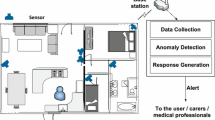Abstract
This paper describes fall detection, activity recognition and the detection of anomalous gait in the Confidence project. The project aims to prolong the independence of the elderly by detecting falls and other types of behavior indicating a health problem. The behavior will be analyzed based on the coordinates of tags worn on the body. The coordinates will be detected with radio sensors. We describe two Confidence modules. The first one classifies the user’s activity into one of six classes, including falling. The second one detects walking anomalies, such as limping, dizziness and hemiplegia. The walking analysis can automatically adapt to each person by using only the examples of normal walking of that person. Both modules employ machine learning: the paper focuses on the features they use and the effect of tag placement and sensor noise on the classification accuracy. Four tags were enough for activity recognition accuracy of over 93% at moderate sensor noise, while six were needed to detect walking anomalies with the accuracy of over 90%.
Preview
Unable to display preview. Download preview PDF.
Similar content being viewed by others
References
Bourke, A.K., Lyons, G.M.: A threshold-based fall-detection algorithm using a bi-axial gyroscope sensor. Medical Engineering & Physics 30(1), 84–90 (2006)
Breunig, M.M., Kriegel, H.-P., Ng, R.T., Sander, J.: LOF: Identifying density-based local outliers. In: 2000 ACM SIGMOD International Conference on Management of Data, pp. 93–104 (2000)
Confidence: Ubiquitous Care System to Support Independent Living, http://www.confidence-eu.org
Craik, R., Oatis, C.: Gait Analysis: Theory and Application. Mosby-Year Book (1995)
Heiden, T.L., Sanderson, D.J., Inglis, J.T., Siegmund, G.P.: Adaptations to normal human gait on potentially slippery surfaces: The effects of awareness and prior slip experience. Gait & Posture 24, 237–246 (2006)
Kangas, M., Konttila, A., Lindgren, P., Winblad, P., Jamsa, T.: Comparison of low-complexity fall detection algorithms for body attached accelerometers. Gait & Posture 28(2), 285–291 (2008)
Lakany, H.: Extracting a diagnostic gait signature. Pattern recognition 41, 1627–1637 (2008)
Luštrek, M., Kaluža, B.: Fall detection and activity recognition with machine learning. Informatica 33(2), 205–212 (2009)
Paróczai, R., Bejek, Z., Illyés, Á., Kocsis, L., Kiss, R.M.: Gait parameters of healthy, elderly people. Facta Universitatis 4(1), 49–58 (2006)
Sukthankar, G., Sycara, K.: A cost minimization approach to human behavior recognition. In: The Fourth International Joint Conference on Autonomous Agents and Multi-Agent Systems (AAMAS), pp. 1067–1074 (2005)
Tapia, E.M., Intille, S.S., Haskell, W., Larson, K., Wright, J., King, A., Friedman, R.: Real-time recognition of physical activities and their intensities using wireless accelerometers and a heart rate monitor. In: The 6th International Semantic Web Conference, pp. 37–40 (2007)
Witten, I.H., Frank, E.: Data Mining: Practical Machine Learning Tools and Techniques, 2nd edn. Morgan Kaufmann, San Francisco (2005)
Zhang, T., Wang, J., Liu, P., Hou, J.: Fall detection by wearable sensor and One-Class SVM algorithm. In: Nossum, R.T. (ed.) ACAI 1987. LNCS, vol. 345, pp. 858–863. Springer, Heidelberg (1988)
Author information
Authors and Affiliations
Editor information
Editors and Affiliations
Rights and permissions
Copyright information
© 2009 Springer-Verlag Berlin Heidelberg
About this paper
Cite this paper
Luštrek, M., Kaluža, B., Dovgan, E., Pogorelc, B., Gams, M. (2009). Behavior Analysis Based on Coordinates of Body Tags. In: Tscheligi, M., et al. Ambient Intelligence. AmI 2009. Lecture Notes in Computer Science, vol 5859. Springer, Berlin, Heidelberg. https://doi.org/10.1007/978-3-642-05408-2_2
Download citation
DOI: https://doi.org/10.1007/978-3-642-05408-2_2
Publisher Name: Springer, Berlin, Heidelberg
Print ISBN: 978-3-642-05407-5
Online ISBN: 978-3-642-05408-2
eBook Packages: Computer ScienceComputer Science (R0)




